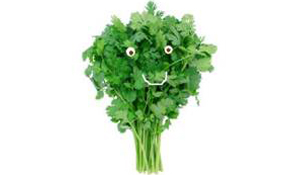Also known as: Coriander leaves
Likes: Dressing up dishes the world over
Dislikes: Being described as “soapy”
Hobbies: Enjoying the sun with Basil and Parsley in the herb garden
Find him: Chopped and atop soups and main dishes from Thailand to Mexico, pureed into salsa and cilantro pesto, simmered in lentils and curries
Do you love or hate Cilantro? If you’re like the majority of food-lovers in the world, you love him, and that’s just what he likes to hear. Whether you chop Cilantro and add him to your enchiladas as a flavorful garnish or wrap him up with his garden fresh veggie friends in an Asian spring roll, you’ll be taking advantage of a fresh and powerful taste and plenty of health benefits.
Like his herb and spice cousins, Cilantro can add a vibrant and distinct flavor to a variety of dishes without adding extra sodium, fat or many calories (¼ cup has less than 10 calories). He’s a good source of vitamin K, which helps with blood clotting, and some studies have shown that Cilantro can help lower “bad” cholesterol and raise “good” cholesterol. Whether you’re watching your weight, cholesterol, blood pressure or all of the above, he can flavor your healthy diet every day of the week.
Of course, Cilantro does like to stand out from the herb garden a bit. Go ahead and ask him about his antibacterial properties. He’s not shy about showing you how he can take care of any rogue salmonella bacteria lurking in your favorite healthy foods. A knight in leafy green armor!
Cilantro has a long history of flavoring foods and improving health, from ancient Greece and Egypt to today. Over the centuries, he has also been enjoyed as an aid in digestion, to help regulate blood sugar and to remove heavy metals from the body. Though some of his uses have yet to be proven in modern scientific studies, if asked, Cilantro would refer you back to Socrates for recommendation.
Search for Healthy Dining menu choices featuring cilantro in your area here!

